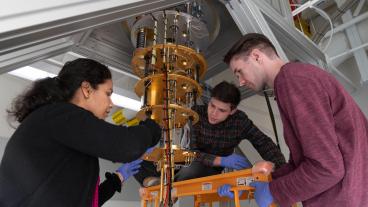Coal serves as the nation’s largest fossil-fuel resource, responsible for approximately 40 percent of electricity generation in the U.S., but as it remains a great source of air pollution, the Thermal-Fluids Systems group in the Colorado School of Mines Department of Mechanical Engineering is investigating how to harness coal’s energy with the low-carbon technology found in gasification.
Coal gasification as a source of energy depends on advances in the technology, specifically in full carbon capture and storage. Mechanical Engineering Assistant Professor Jason Porter and his graduate student, Madison Kelley, are currently focused on two projects: the first focuses on developing membrane separators and the second is focused on developing a model for char kinetics.
The Mines gasifier is a high-temperature, high pressure, entrained-flow, laboratory-scale system capable of operating at temperatures and pressures up to 1650°C and 40 bar) to generate pure hydrogen using membrane separators. It is unique in its maximum operating pressure, feed rate and ability to switch between flow regimes.
“Basically you have coal and steam,” explained Kelley, “and then it produces hydrogen and carbon monoxide, which is called syngas. It gets the name from its use as a means of creating synthetic natural gas, as well as producing ammonia or methanol.”
Working with Professor Doug Way and his graduate student, Neil Patki, in the Chemical and Biological Engineering Department at Mines, the research team is using gold-alloyed membrane separators that create a sulfur resistance. The project is funded by a grant from Praxair and the Department of Energy.
“Right now there is limited understanding of gasification reactions under the high temperature and pressure conditions typical of commercial gasifiers,” said Kelley. “We will be providing fundamental data needed to improve coal gasification for commercial reactors.”
In collaboration with Professor Greg Rieker at the University of Colorado-Boulder, Porter’s research group is using laser diagnostics to measure the different chemical species that are produced during the conversion.
“We have nine optical ports through which we can feed the lasers,” Kelley continued. “The point is to develop a model for char kinetics – to learn what, exactly, takes place when you gasify coal or biomass at high temperature and pressure.”
The Mines Thermal-Fluids Systems group strives to advance the science and engineering of high-performance energy-conversion technologies, including fuel cells, photovoltaics and rechargeable batteries. With continued collaboration and research, their research can lead the way to cleaner and cheaper energy production.
Contact:
Deirdre Keating, Information Specialist, College of Engineering & Computational Sciences | 303-384-2358 | dkeating@mines.edu
Karen Gilbert, Director of Public Relations, Colorado School of Mines | 303-273-3541 | kgilbert@mines.edu



